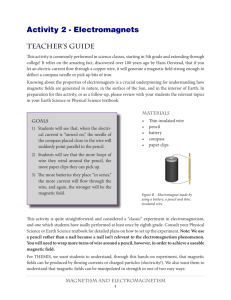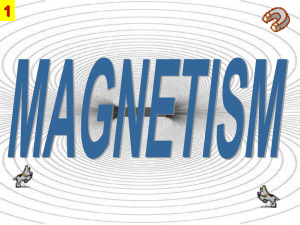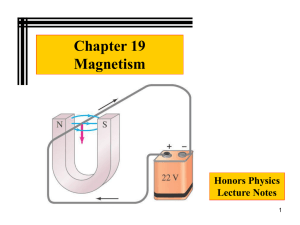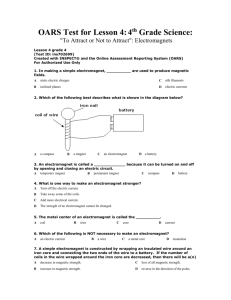Electro-Magnet
advertisement
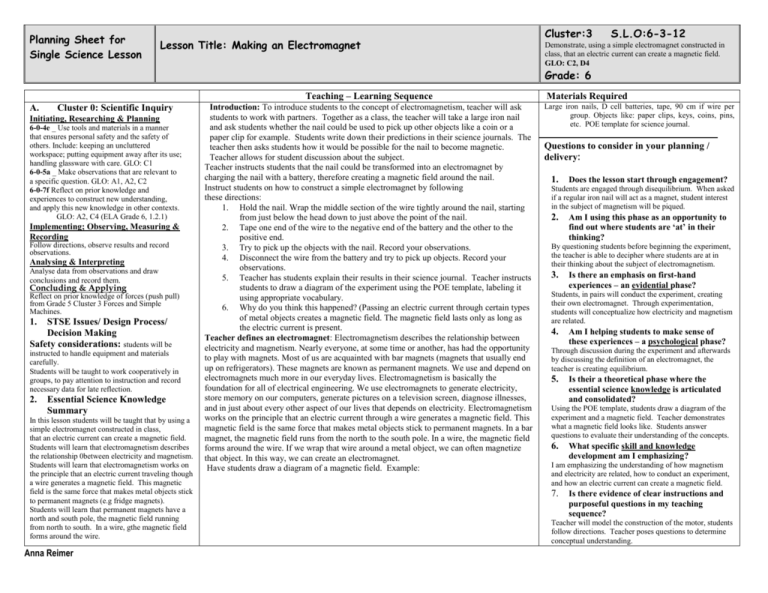
Planning Sheet for Single Science Lesson Lesson Title: Making an Electromagnet Cluster:3 S.L.O:6-3-12 Demonstrate, using a simple electromagnet constructed in class, that an electric current can create a magnetic field. GLO: C2, D4 Grade: 6 Teaching – Learning Sequence A. Cluster 0: Scientific Inquiry Initiating, Researching & Planning 6-0-4e _ Use tools and materials in a manner that ensures personal safety and the safety of others. Include: keeping an uncluttered workspace; putting equipment away after its use; handling glassware with care. GLO: C1 6-0-5a _ Make observations that are relevant to a specific question. GLO: A1, A2, C2 6-0-7f Reflect on prior knowledge and experiences to construct new understanding, and apply this new knowledge in other contexts. GLO: A2, C4 (ELA Grade 6, 1.2.1) Implementing; Observing, Measuring & Recording Follow directions, observe results and record observations. Analysing & Interpreting Analyse data from observations and draw conclusions and record them. Concluding & Applying Reflect on prior knowledge of forces (push pull) from Grade 5 Cluster 3 Forces and Simple Machines. 1. STSE Issues/ Design Process/ Decision Making Safety considerations: students will be instructed to handle equipment and materials carefully. Students will be taught to work cooperatively in groups, to pay attention to instruction and record necessary data for late reflection. 2. Essential Science Knowledge Summary In this lesson students will be taught that by using a simple electromagnet constructed in class, that an electric current can create a magnetic field. Students will learn that electromagnetism describes the relationship 0between electricity and magnetism. Students will learn that electromagnetism works on the principle that an electric current traveling though a wire generates a magnetic field. This magnetic field is the same force that makes metal objects stick to permanent magnets (e.g fridge magnets). Students will learn that permanent magnets have a north and south pole, the magnetic field running from north to south. In a wire, gthe magnetic field forms around the wire. Anna Reimer Introduction: To introduce students to the concept of electromagnetism, teacher will ask students to work with partners. Together as a class, the teacher will take a large iron nail and ask students whether the nail could be used to pick up other objects like a coin or a paper clip for example. Students write down their predictions in their science journals. The teacher then asks students how it would be possible for the nail to become magnetic. Teacher allows for student discussion about the subject. Teacher instructs students that the nail could be transformed into an electromagnet by charging the nail with a battery, therefore creating a magnetic field around the nail. Instruct students on how to construct a simple electromagnet by following these directions: 1. Hold the nail. Wrap the middle section of the wire tightly around the nail, starting from just below the head down to just above the point of the nail. 2. Tape one end of the wire to the negative end of the battery and the other to the positive end. 3. Try to pick up the objects with the nail. Record your observations. 4. Disconnect the wire from the battery and try to pick up objects. Record your observations. 5. Teacher has students explain their results in their science journal. Teacher instructs students to draw a diagram of the experiment using the POE template, labeling it using appropriate vocabulary. 6. Why do you think this happened? (Passing an electric current through certain types of metal objects creates a magnetic field. The magnetic field lasts only as long as the electric current is present. Teacher defines an electromagnet: Electromagnetism describes the relationship between electricity and magnetism. Nearly everyone, at some time or another, has had the opportunity to play with magnets. Most of us are acquainted with bar magnets (magnets that usually end up on refrigerators). These magnets are known as permanent magnets. We use and depend on electromagnets much more in our everyday lives. Electromagnetism is basically the foundation for all of electrical engineering. We use electromagnets to generate electricity, store memory on our computers, generate pictures on a television screen, diagnose illnesses, and in just about every other aspect of our lives that depends on electricity. Electromagnetism works on the principle that an electric current through a wire generates a magnetic field. This magnetic field is the same force that makes metal objects stick to permanent magnets. In a bar magnet, the magnetic field runs from the north to the south pole. In a wire, the magnetic field forms around the wire. If we wrap that wire around a metal object, we can often magnetize that object. In this way, we can create an electromagnet. Have students draw a diagram of a magnetic field. Example: Materials Required Large iron nails, D cell batteries, tape, 90 cm if wire per group. Objects like: paper clips, keys, coins, pins, etc. POE template for science journal. Questions to consider in your planning / delivery: 1. Does the lesson start through engagement? Students are engaged through disequilibrium. When asked if a regular iron nail will act as a magnet, student interest in the subject of magnetism will be piqued. 2. Am I using this phase as an opportunity to find out where students are ‘at’ in their thinking? By questioning students before beginning the experiment, the teacher is able to decipher where students are at in their thinking about the subject of electromagnetism. 3. Is there an emphasis on first-hand experiences – an evidential phase? Students, in pairs will conduct the experiment, creating their own electromagnet. Through experimentation, students will conceptualize how electricity and magnetism are related. 4. Am I helping students to make sense of these experiences – a psychological phase? Through discussion during the experiment and afterwards by discussing the definition of an electromagnet, the teacher is creating equilibrium. 5. Is their a theoretical phase where the essential science knowledge is articulated and consolidated? Using the POE template, students draw a diagram of the experiment and a magnetic field. Teacher demonstrates what a magnetic field looks like. Students answer questions to evaluate their understanding of the concepts. 6. What specific skill and knowledge development am I emphasizing? I am emphasizing the understanding of how magnetism and electricity are related, how to conduct an experiment, and how an electric current can create a magnetic field. 7. Is there evidence of clear instructions and purposeful questions in my teaching sequence? Teacher will model the construction of the motor, students follow directions. Teacher poses questions to determine conceptual understanding. Will you assess? If so, what? Teacher will assess student understanding of they concepts by moving throughout the classroom as groups are creating their electromagnets. Teacher will ensure students are following directions and questioning students to evaluate understanding of the concepts presented. How will you assess it? Students will hand in completed POE templates and will be evaluated on labelled diagrams, using appropriate vocabulary and assessed on conceptual understanding by evaluating how well students answered the given questions. Anna Reimer Diagram of a Magnetic Field



